Towards Sustainable Hydrocarbon Extraction: A Study of Atmospheric Pollutant Dynamics (CO, CH4, SO2, HCHO) via Remote Sensing and Meteorological Data
Abstract
1. Introduction
2. Materials and Methods
2.1. Study Area
2.2. Data Acquisition and Preprocessing
Satellite Data on Polluting Gases
2.3. Spatial and Statistical Analysis
3. Results
4. Discussion
5. Conclusions
Author Contributions
Funding
Institutional Review Board Statement
Informed Consent Statement
Data Availability Statement
Acknowledgments
Conflicts of Interest
References
- Omobolanle, O.C.; Ikiensikimama, S.S. Gas flaring: Technicalities, challenges, and the economic potentials. Environ. Sci. Pollut. Res. 2024, 31, 40838–40850. [Google Scholar] [CrossRef] [PubMed]
- Fawole, O.G.; Cai, X.M.; MacKenzie, A.R. Gas flaring and resultant air pollution: A review focusing on black carbon. Environ. Pollut. 2016, 216, 182–197. [Google Scholar] [CrossRef]
- Puliafito, S.E.; Bolaño-Ortiz, T.R.; Fernandez, R.P.; Berná, L.L.; Pascual-Flores, R.M.; Urquiza, J.; Tames, M.F. High Resolution Seasonal and Decadal Inventory of Anthropic Gas-Phase and Particle Emissions for Argentina. Earth Syst. Sci. Data Discuss. 2021, 13, 5027–5069. [Google Scholar] [CrossRef]
- IAE Mosconi. Informe anual de hidrocarburos—Año 2023; Lic. Julián Rojo (dir. área técnica); Instituto Argentino de Energía “General Mosconi”: Buenos Aires, Argentina, 2023; Available online: https://www.iae.org.ar/wp-content/uploads/2024/03/Informe-anual-de-hidrocarburos-2023.pdf (accessed on 15 August 2025).
- Lu, X.; Li, S.; Han, R.; Jia, B.; Xian, C.; Ding, F.; Zuo, X. An overview of recent developments and understandings of unconventionals in the Vaca Muerta formation, Argentina. Appl. Sci. 2024, 14, 1366. [Google Scholar] [CrossRef]
- Belotti, H.; Pagan, F.; Mazas, A.P.; Agüera, M.; Rodriguez, J.; Porras, J.; Cagnolatti, M. Geologic interpretation and assessment of Early Cretaceous shale oil and gas potential in Austral Basin, Santa Cruz, Argentina. In Proceedings of the Unconventional Resources Technology Conference, Denver, CO, USA, 12–14 August 2013; SEG Global Meeting. 2013; pp. 926–935, ISSN 2159-6832 Published in electronic format with permission by the Society of Exploration Geophysicists, American Association of Petroleum Geologists, and Society of Petroleum Engineers. [Google Scholar] [CrossRef]
- Sachse, V.F.; Strozyk, F.; Anka, Z.; Rodriguez, J.F.; di Primio, R. The tectono-stratigraphic evolution of the Austral Basin and adjacent areas against the background of Andean tectonics, southern Argentina, South America. Basin Res. 2016, 28, 462–482. [Google Scholar] [CrossRef]
- Gao, Z.; Ivey, C.E.; Blanchard, C.L.; Do, K.; Lee, S.M.; Russell, A.G. Emissions and meteorological impacts on PM2.5 species concentrations in Southern California using generalized additive modeling. Sci. Total Environ. 2023, 891, 164464. [Google Scholar] [CrossRef]
- Alvarez, R.A.; Zavala-Araiza, D.; Lyon, D.R.; Allen, D.T.; Barkley, Z.R.; Brandt, A.R.; Davis, K.J.; Herndon, S.C.; Jacob, D.J.; Karion, A.; et al. Assessment of methane emissions from the US oil and gas supply chain. Science 2018, 361, 186–188. [Google Scholar] [CrossRef]
- Kuttippurath, J.; Abbhishek, K.; Gopikrishnan, G.S. Investigation of long-term trends and major sources of atmospheric HCHO over India. Environ. Chall. 2022, 7, 100477. [Google Scholar] [CrossRef]
- Lopez, P.; Casallas, A.; Zhou, G.; Zhang, K.; Jing, G.; Ali, A.; Lopez-Barrera, E.; Belalcazar, L.; Rojas, N.; Jiang, H. High-resolution anthropogenic emission inventories with deep learning in northern South America. Remote Sens. Environ. 2025, 324, 114761. [Google Scholar] [CrossRef]
- Radovich, V.S. Hydrocarbons in Argentine Republic. In Marine Exploration and Exploitation of Hydrocarbons; Palgrave Studies in Maritime Politics and Security; Palgrave Macmillan: Cham, Switzerland, 2025; pp. 149–202. [Google Scholar] [CrossRef]
- Báez, M.; Stinco, L.P.; Barredo, S.P.; Merlino, H.D. Data Science Applied to Oil Wells’ Behavior Prediction in the Estructura Cruz de Piedra–Lunlunta Oil Field, Cuyana Basin, Argentina. In ICAI Workshops (Joint Proceedings of the ICAI 2021 Workshops WAAI 2021, AIESD 2021, WDEA 2021, WKMIT 2021, WSSC 2021); Florez, H., Galpin, I., Grévisse, C., Eds.; CEUR Workshop Proceedings; CEUR-WS.org: Buenos Aires, Argentina, 2021; Volume 2992, pp. 1–15. [Google Scholar]
- Schenk, C.J.; Klett, T.R.; Tennyson, M.E.; Mercier, T.J.; Pitman, J.K.; Gaswirth, S.B.; Finn, T.M.; Brownfield, M.E.; Le, P.A.; Leathers-Miller, H.M.; et al. Assessment of Continuous Oil and Gas Resources in the Neuquén Basin Province, Argentina, 2016; Report No. 2017–3025; US Geological Survey: Reston, VA, USA, 2017. [CrossRef]
- Borsdorff, T.; aan de Brugh, J.; Hu, H.; Hasekamp, O.; Sussmann, R.; Rettinger, M.; Hase, F.; Gross, J.; Schneider, M.; Garcia, O.; et al. Mapping carbon monoxide pollution from space down to city scales with daily global coverage. Atmos. Meas. Tech. 2018, 11, 5507–5518. [Google Scholar] [CrossRef]
- Lorente, A.; Borsdorff, T.; Butz, A.; Hasekamp, O.; de Brugh, J.; Schneider, A.; Wu, L.; Hase, F.; Kivi, R.; Wunch, D.; et al. Methane retrieved from TROPOMI: Improvement of the data product and validation of the first 2 years of measurements. Atmos. Meas. Tech. 2021, 14, 665–684. [Google Scholar] [CrossRef]
- Theys, N.; Hedelt, P.; De Smedt, I.; Lerot, C.; Yu, H.; Vlietinck, J.; Pedergnana, M.; Arellano, S.; Galle, B.; Fernandez, D.; et al. Global monitoring of volcanic SO2 degassing with unprecedented resolution from TROPOMI onboard Sentinel-5 Precursor. Sci. Rep. 2019, 9, 2643. [Google Scholar] [CrossRef]
- De Smedt, I.; Theys, N.; Yu, H.; Danckaert, T.; Lerot, C.; Compernolle, S.; Van Roozendael, M.; Richter, A.; Hilboll, A.; Peters, E.; et al. Algorithm theoretical baseline for formaldehyde retrievals from S5P TROPOMI and from the QA4ECV project. Atmos. Meas. Tech. 2018, 11, 2395–2426. [Google Scholar] [CrossRef]
- Crawley, M.J. The R Book, 2nd ed.; John Wiley & Sons, Ltd.: Sussex, EEUU, 2013; pp. 388–448. ISBN 9781118448908. [Google Scholar] [CrossRef]
- Zar, J. Biostatistical Analysis, 5th ed.; Pearson Prentice Hall: Upper Saddle River, NJ, USA, 1999. [Google Scholar]
- Jackson, R.B.; Saunois, M.; Bousquet, P.; Canadell, J.G.; Poulter, B.; Stavert, A.R.; Tsuruta, A. Increasing anthropogenic methane emissions arise equally from agricultural and fossil fuel sources. Environ. Res. Lett. 2020, 15, 071002. [Google Scholar] [CrossRef]
- Cooper, J.; Dubey, L.; Hawkes, A. Methane detection and quantification in the upstream oil and gas sector: The role of satellites in emissions detection, reconciling and reporting. Environ. Sci. Atmos. 2022, 2, 9–23. [Google Scholar] [CrossRef]
- Gobierno de Mendoza, Argentina. Petróleo en Mendoza: Política Petrolera 2006–2007; Ministerio de Economía, Subsecretaría de Promoción Económica e Inversiones: 2006. Available online: https://www.energia.gob.ar/contenidos/verpagina.php?idpagina=2357 (accessed on 15 June 2025).
- Mayer, M.; Schreier, S.F.; Spangl, W.; Staehle, C.; Trimmel, H.; Rieder, H.E. An analysis of 30 years of surface ozone concentrations in Austria: Temporal evolution, changes in precursor emissions and chemical regimes, temperature dependence, and lessons for the future. Environ. Sci. Atmos. 2022, 2, 601–615. [Google Scholar] [CrossRef]
- Tran, H.; Polka, E.; Buonocore, J.J.; Roy, A.; Trask, B.; Hull, H.; Arunachalam, S. Air quality and health impacts of onshore oil and gas flaring and venting activities estimated using refined satellite-based emissions. GeoHealth 2024, 8, e2023GH000938. [Google Scholar] [CrossRef] [PubMed]
- Fernández-Maldonado, V.; Navas, A.L.; Fabani, M.P.; Mazza, G.; Rodríguez, R. A multi-temporal analysis on the dynamics of the impact of land use and land cover on NO2 and CO emissions in Argentina for sustainable environmental management. Sustainability 2024, 16, 4400. [Google Scholar] [CrossRef]
- Liu, P.; Song, H.; Wang, T.; Wang, F.; Li, X.; Miao, C.; Zhao, H. Effects of meteorological conditions and anthropogenic precursors on ground-level ozone concentrations in Chinese cities. Environ. Pollut. 2020, 262, 114366. [Google Scholar] [CrossRef] [PubMed]
- Akyuz, E.; Kaynak, B. Use of dispersion model and satellite SO2 retrievals for environmental impact assessment of coal-fired power plants. Sci. Total Environ. 2019, 689, 808–819. [Google Scholar] [CrossRef]
- Benites Morales, O.F.; Pacsi Valdivia, S.A. Análisis temporal de los contaminantes atmosféricos (NO2, O3 troposférico y CO) y su relación con la temperatura del aire y la radiación solar en Lima Metropolitana. Ecol. Apl. 2023, 22, 17–25. [Google Scholar] [CrossRef]
- Calkins, C.; Ge, C.; Wang, J.; Anderson, M.; Yang, K. Effects of meteorological conditions on sulfur dioxide air pollution in the North China Plain during winters of 2006–2015. Atmos. Environ. 2016, 147, 296–309. [Google Scholar] [CrossRef]
- Nisbet, E.G.; Manning, M.R.; Dlugokencky, E.J.; Michel, S.E.; Lan, X.; Röckmann, T.; Denier van der Gon, H.A.C.; Schmitt, J.; Palmer, P.I.; Dyonisius, M.N.; et al. Atmospheric methane: Comparison between methane’s record in 2006–2022 and during glacial terminations. Glob. Biogeochem. Cycles 2023, 37, e2023GB007875. [Google Scholar] [CrossRef]
- Bussmann, I.; Achterberg, E.P.; Brix, H.; Brüggemann, N.; Flöser, G.; Schütze, C.; Fischer, P. Influence of wind strength and direction on diffusive methane fluxes and atmospheric methane concentrations above the North Sea. Biogeosciences 2024, 21, 3819–3838. [Google Scholar] [CrossRef]
- Yin, Q.; Ma, Q.; Lin, W.; Xu, X.; Yao, J. Measurement report: Long-term variations in surface NO2 and SO2 mixing ratios from 2006 to 2016 at a background site in the Yangtze River Delta region, China. Atmos. Chem. Phys. 2022, 22, 1015–1033. [Google Scholar] [CrossRef]
- Chauhan, B.V.; Smallbone, K.L.; Berg, M.; Wyche, K.P. The temporal evolution of HCHO and changes in atmospheric composition in the southeast of the United Kingdom. Case Stud. Chem. Environ. Eng. 2025, 11, 101092. [Google Scholar] [CrossRef]
- Niu, X.; Ju, T.; Li, B.; Huang, C.; Zhang, J.; Lei, S. Characteristics, future trends, and transport path analysis of atmospheric formaldehyde pollution: A case study of Argentina. Acad. J. Environ. Earth Sci. 2024, 6, 43–53. [Google Scholar] [CrossRef]
- Oomen, G.M.; Müller, J.F.; Stavrakou, T.; De Smedt, I.; Blumenstock, T.; Kivi, R.; Makarova, M.; Palm, M.; Röhling, A.; Té, Y.; et al. Weekly derived top-down volatile-organic-compound fluxes over Europe from TROPOMI HCHO data from 2018 to 2021. Atmos. Chem. Phys. 2024, 24, 449–474. [Google Scholar] [CrossRef]
- Hu, M.; Wang, Y.; Wang, S.; Jiao, M.; Huang, G.; Xia, B. Spatial–Temporal Heterogeneity of Air Pollution and Its Relationship with Meteorological Factors in the Pearl River Delta, China. Atmos. Environ. 2021, 254, 118415. [Google Scholar] [CrossRef]
- Chen, Z.H.; Cheng, S.Y.; Li, J.B.; Guo, X.R.; Wang, W.H.; Chen, D.S. Relationship between atmospheric pollution processes and synoptic pressure patterns in Northern China. Atmos. Environ. 2008, 42, 6078–6087. [Google Scholar] [CrossRef]
- Cao, J.; Qiu, X.; Gao, J.; Wang, F.; Wang, J.; Wu, J.; Peng, L. Significant decrease in SO2 emission and enhanced atmospheric oxidation trigger changes in sulfate formation pathways in China during 2008–2016. J. Clean. Prod. 2021, 326, 129396. [Google Scholar] [CrossRef]
- Hong, Q.; Liu, C.; Hu, Q.; Xing, C.; Tan, W.; Liu, T.; Liu, J. Vertical distributions of tropospheric SO2 based on MAX-DOAS observations: Investigating the impacts of regional transport at different heights in the boundary layer. J. Environ. Sci. 2021, 103, 119–134. [Google Scholar] [CrossRef] [PubMed]
- Alam, M.J.; Karim, I.; Zaman, S.U. Seasonal dynamics and trends in air pollutants: A comprehensive analysis of PM2.5, NO2, CO, SO2, and O3 in Houston, USA. Air Qual. Atmos. Health 2025, 1–18. [Google Scholar] [CrossRef]
- Martins, L.D.; Hallak, R.; Alves, R.C.; de Almeida, D.S.; Squizzato, R.; Moreira, C.A.; Martins, J.A. Long-range transport of aerosols from biomass burning over southeastern South America and their implications on air quality. Aerosol Air Qual. Res. 2018, 18, 1734–1745. [Google Scholar] [CrossRef]
- Meišutovič-Akhtarieva, M.; Pinto, L.V.; Inácio, M.; Pereira, P. Assessing influential variables affecting outdoor levels of formaldehyde (HCHO). Environ. Process. 2025, 12, 31. [Google Scholar] [CrossRef]
- Zhang, Y.; Ju, T.; Shi, Y.; Wang, Q.; Li, F.; Zhang, G. Analysis of spatiotemporal variation of formaldehyde column concentration in Qinghai–Tibet Plateau and its influencing factors. Environ. Sci. Pollut. Res. 2021, 28, 55233–55251. [Google Scholar] [CrossRef]
- Huertas, J.I.; Martinez, D.S.; Prato, D.F. Numerical approximation to the effects of the atmospheric stability conditions on the dispersion of pollutants over flat areas. Sci. Rep. 2021, 11, 11566. [Google Scholar] [CrossRef]
- Saunois, M.; Martinez, A.; Poulter, B.; Zhang, Z.; Raymond, P.A.; Regnier, P.; Canadell, J.G.; Jackson, R.B.; Patra, P.K.; Bousquet, P.; et al. Global methane budget 2000–2020. Earth Syst. Sci. Data 2025, 17, 1873–1958. [Google Scholar] [CrossRef]
- Du, W.; Tian, Z.; Lv, B.; Wang, P.; Wang, H.; Ding, S.; Tian, Z.; Zhou, J.; Jiao, W.; Zhang, X.; et al. Association of carbon monoxide poisoning with cardiovascular disease risk: A systematic review and meta-analysis. Heliyon 2024, 10, e34062. [Google Scholar] [CrossRef]
- Kuttippurath, J.; Patel, V.K.; Pathak, M.; Singh, A. Improvements in SO2 pollution in India: Role of technology and environmental regulations. Environ. Sci. Pollut. Res. 2022, 29, 78637–78649. [Google Scholar] [CrossRef]
- IARC Working Group on the Evaluation of Carcinogenic Risks to Humans. Formaldehyde. In IARC Monographs on the Evaluation of Carcinogenic Risks to Humans; International Agency for Research on Cancer: Lyon, France, 2006; Volume 88. [Google Scholar]
- World Health Organization. Air Quality and Health—Types of Pollutants; World Health Organization: Geneva, Switzerland, 2021; Available online: https://www.who.int/teams/environment-climate-change-and-health/air-quality-and-health/health-impacts/types-of-pollutants (accessed on 21 August 2025).
- Elliott, E.G.; Trinh, P.; Ma, X.; Leaderer, B.P.; Ward, M.H.; Deziel, N.C. Unconventional oil and gas development and risk of childhood leukemia: Assessing the evidence. Sci. Total Environ. 2017, 576, 138–147. [Google Scholar] [CrossRef] [PubMed]
- McKenzie, L.M.; Witter, R.Z.; Newman, L.S.; Adgate, J.L. Human health risk assessment of air emissions from development of unconventional natural gas resources. Sci. Total Environ. 2012, 424, 79–87. [Google Scholar] [CrossRef] [PubMed]
- IEA. Global Warming Potential (GWP20 for Methane ≈ 84–87). In Methane Tracker 2021; International Energy Agency: Paris, France, 2023; Available online: https://www.iea.org/reports/methane-tracker-2021/methane-and-climate-change (accessed on 20 August 2025).
- UNEP. Global Methane Assessment 2030: Baseline Report—Launching the Global Methane Pledge at COP26 in 2021; United Nations Environment Programme: Nairobi, Kenya, 2022; Available online: https://www.unep.org/resources/report/global-methane-assessment-2030-baseline-report (accessed on 20 August 2025).
- Núñez-Delgado, A. Frontier Studies in Soil Science; Springer: Cham, Switzerland, 2024. [Google Scholar] [CrossRef]

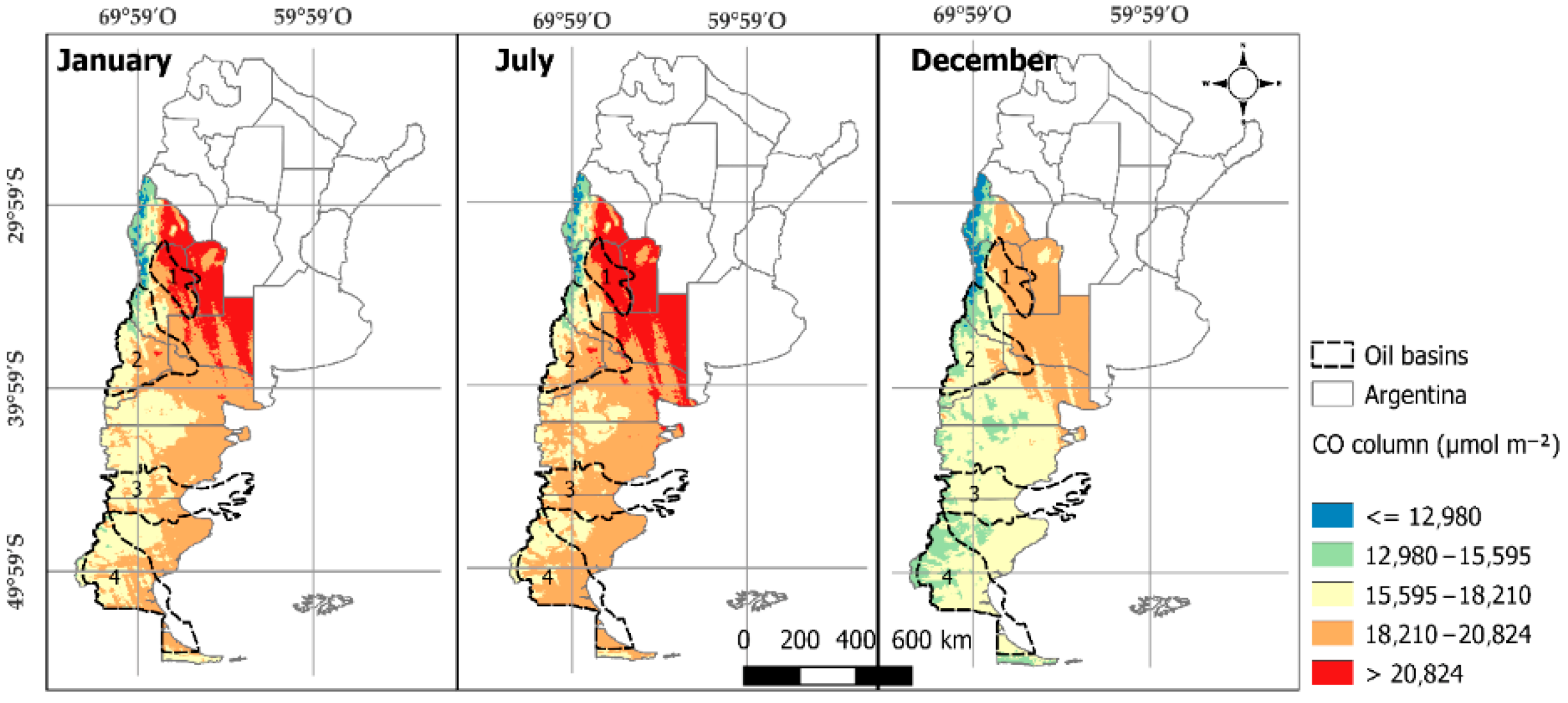
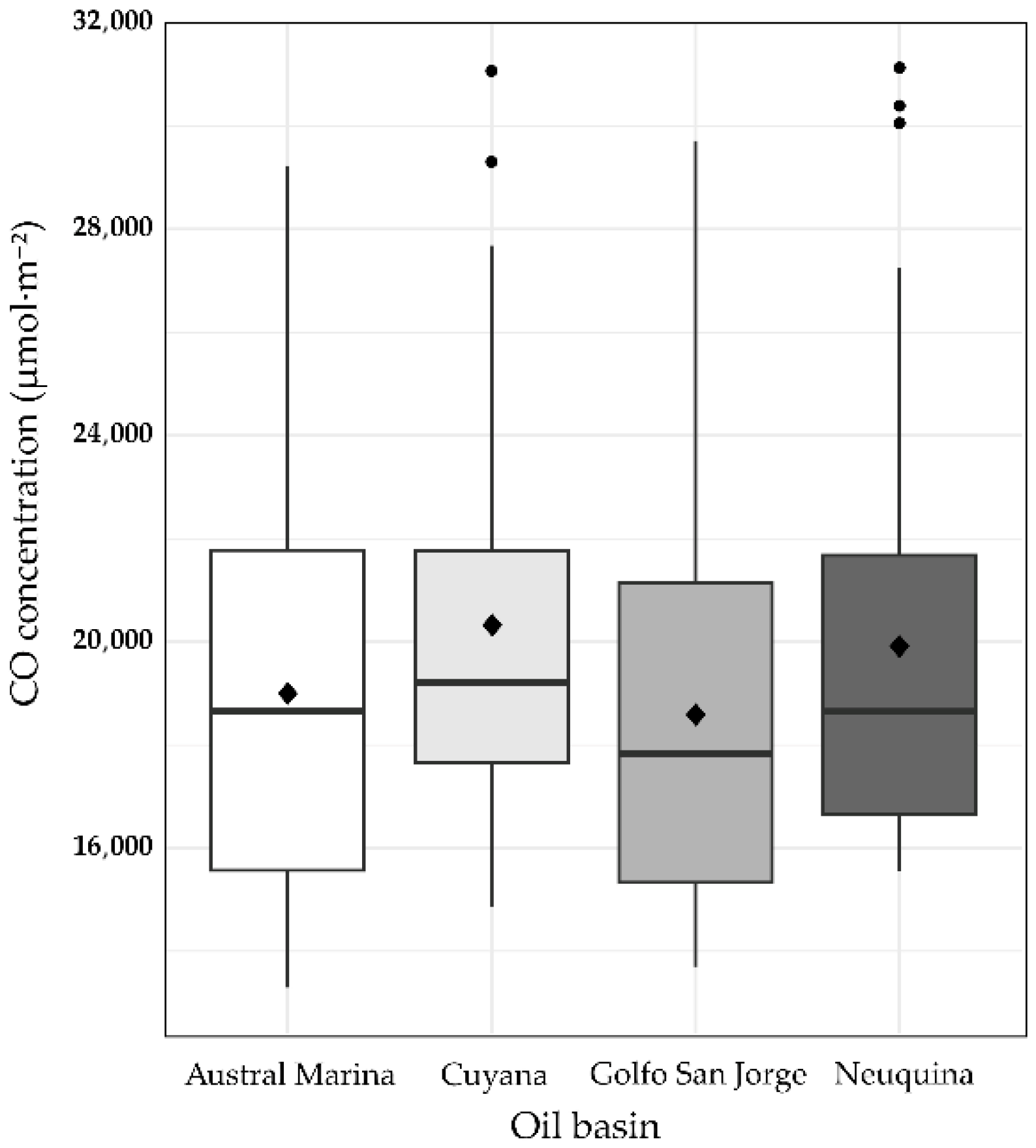
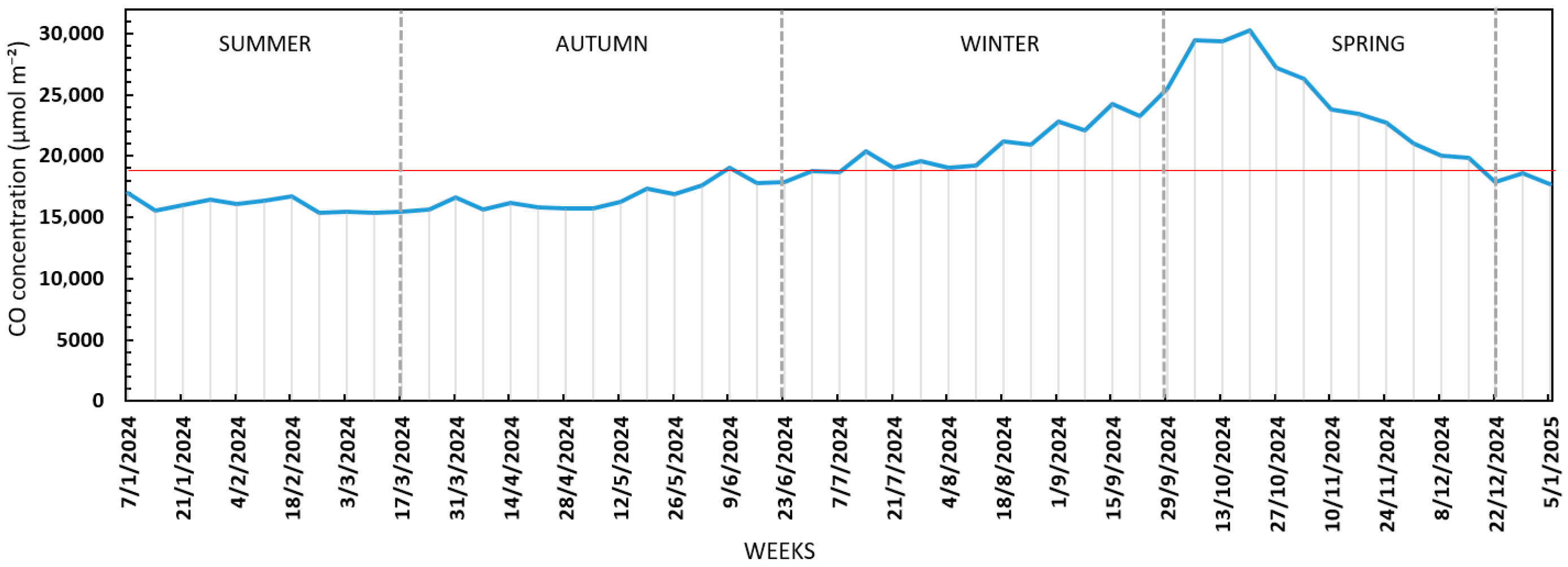
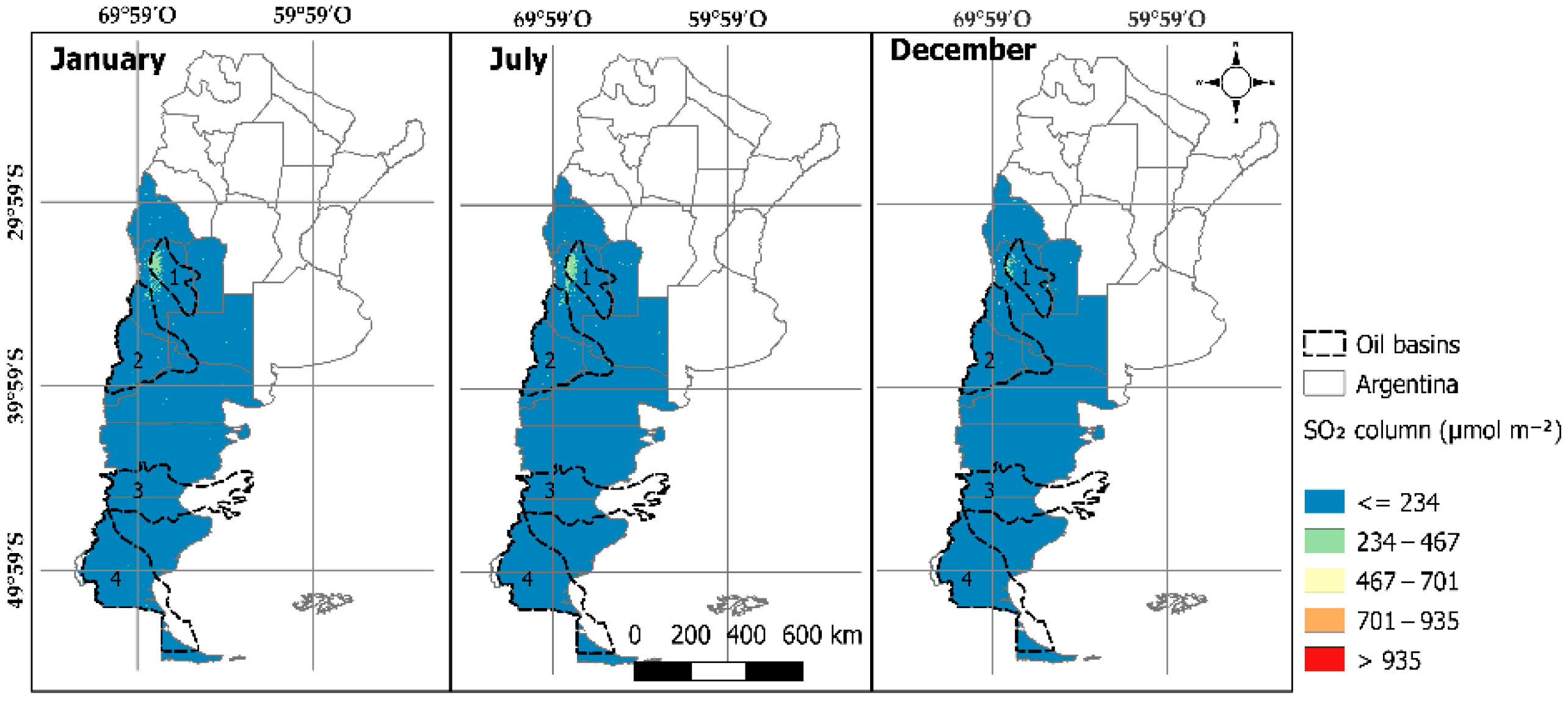
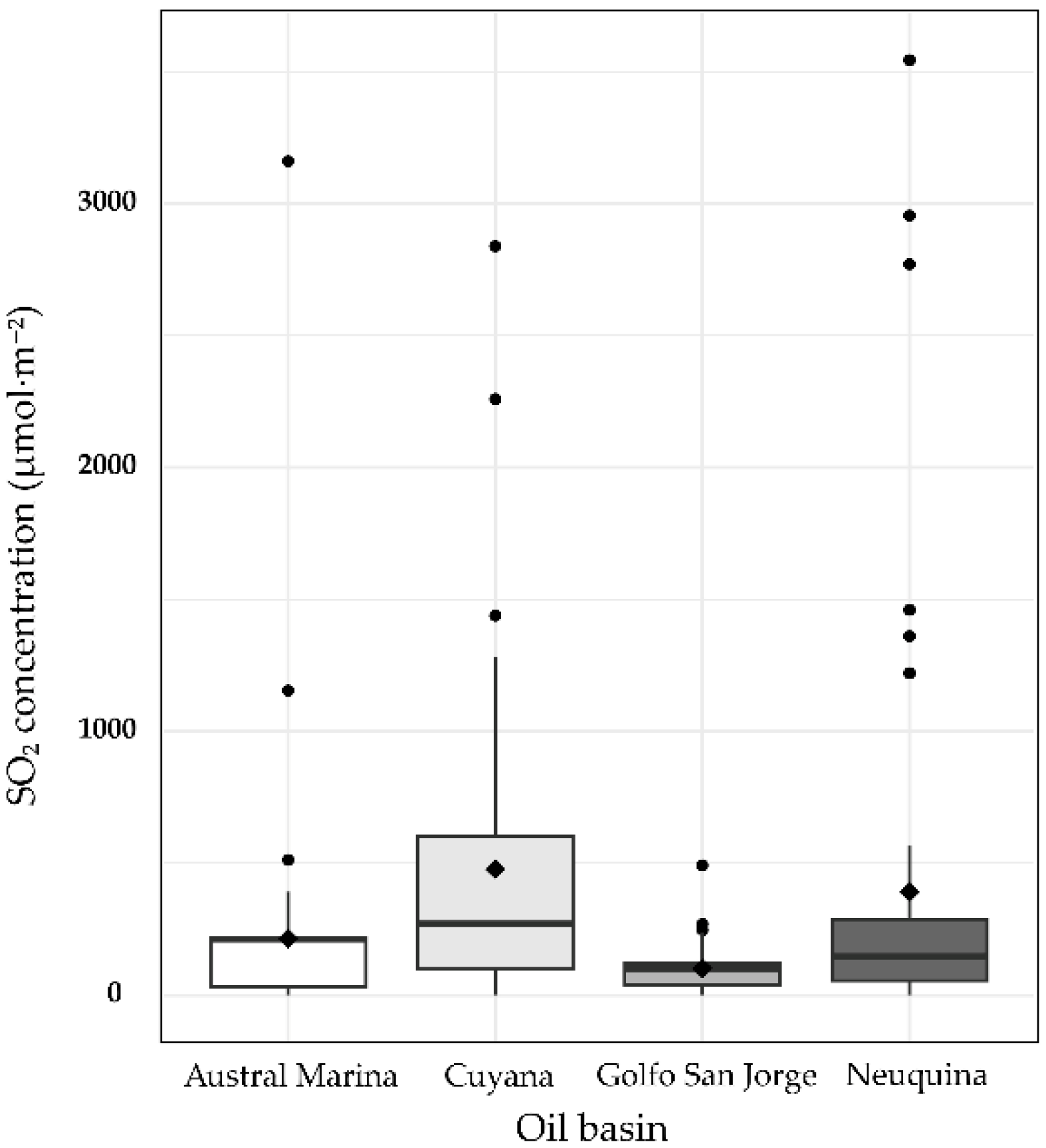

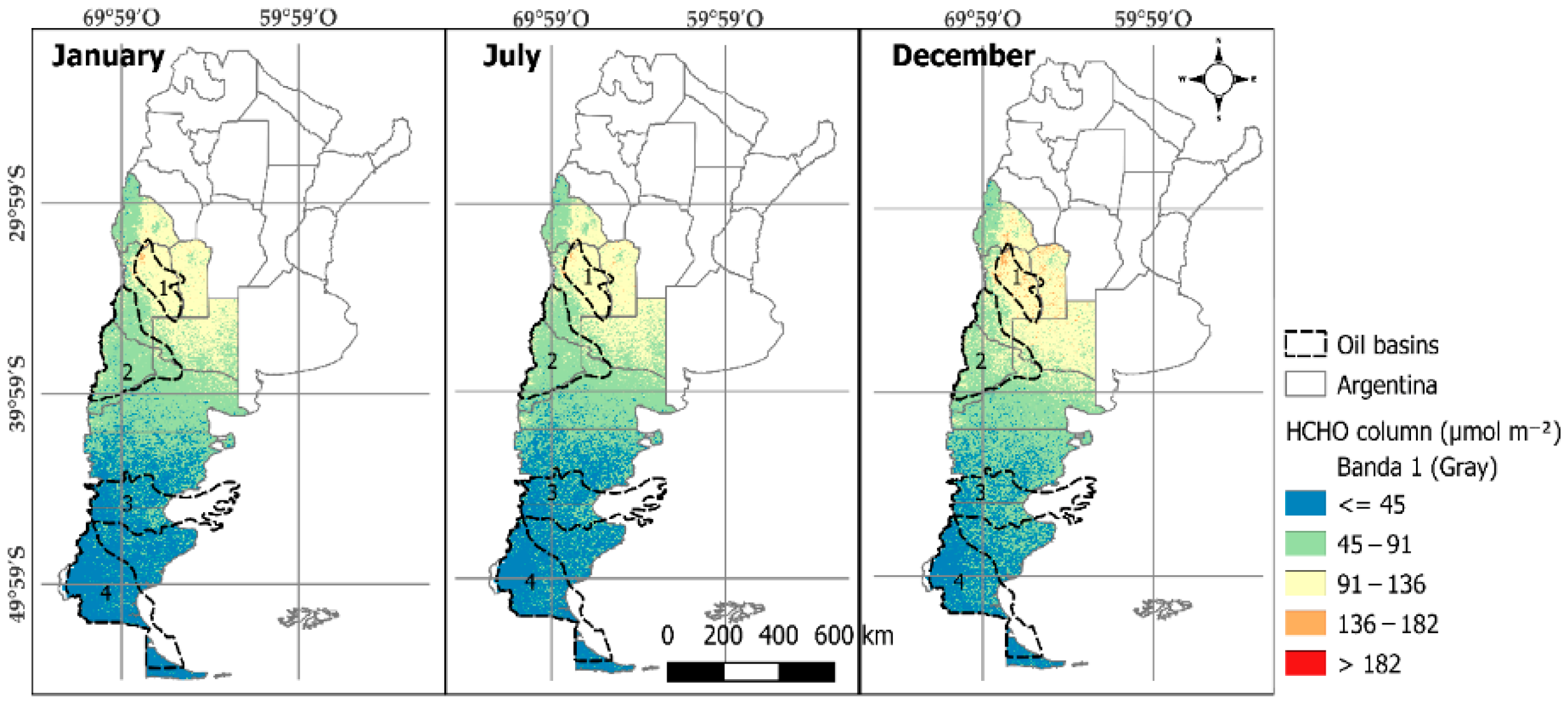
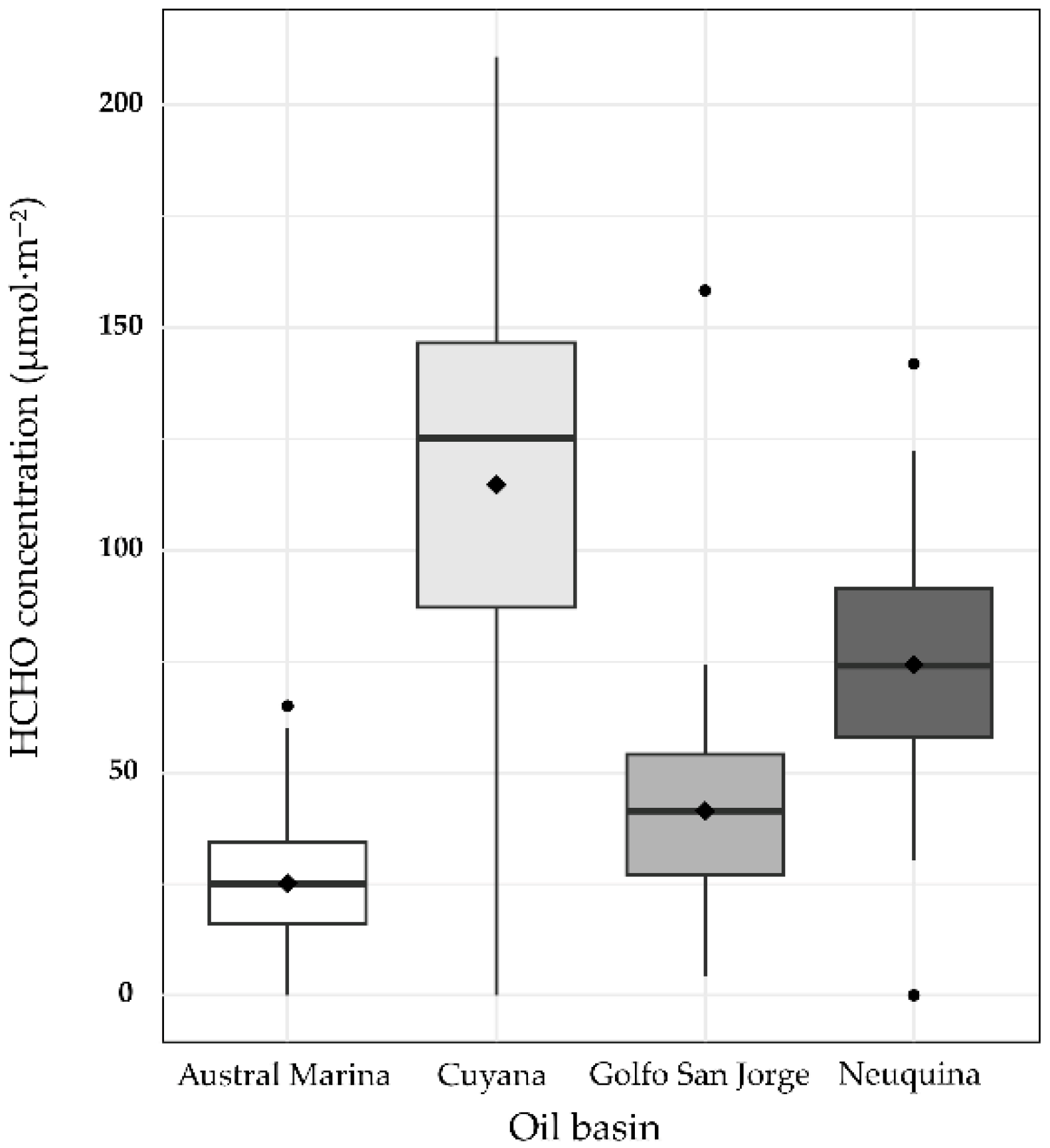
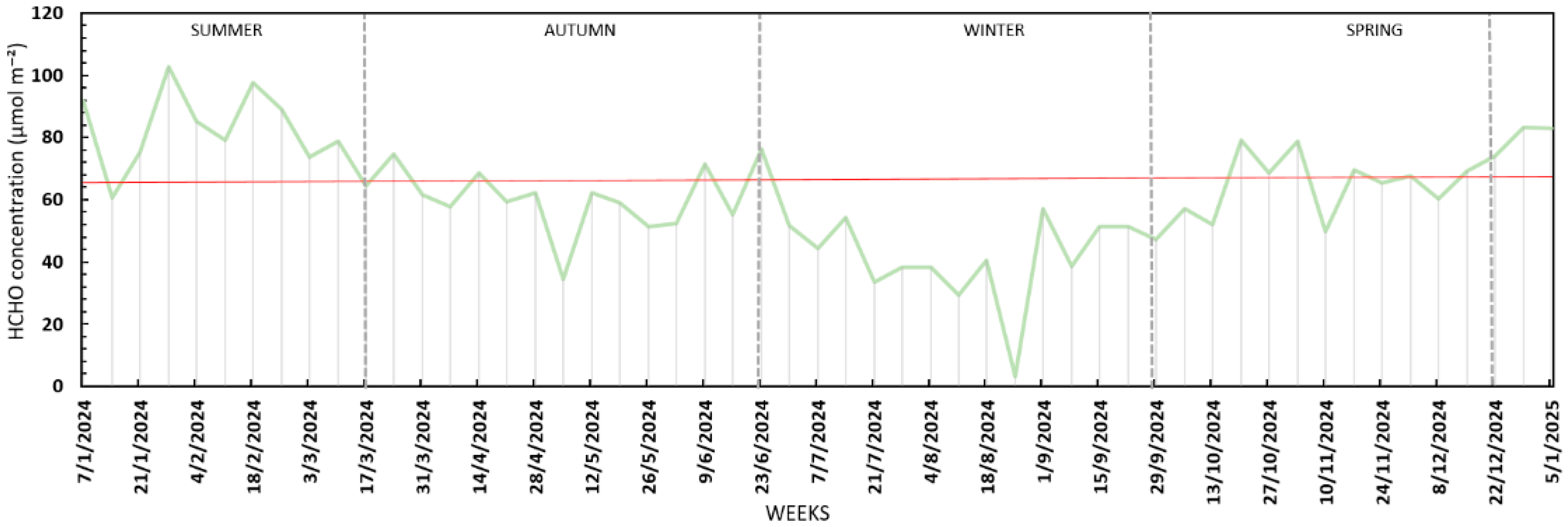
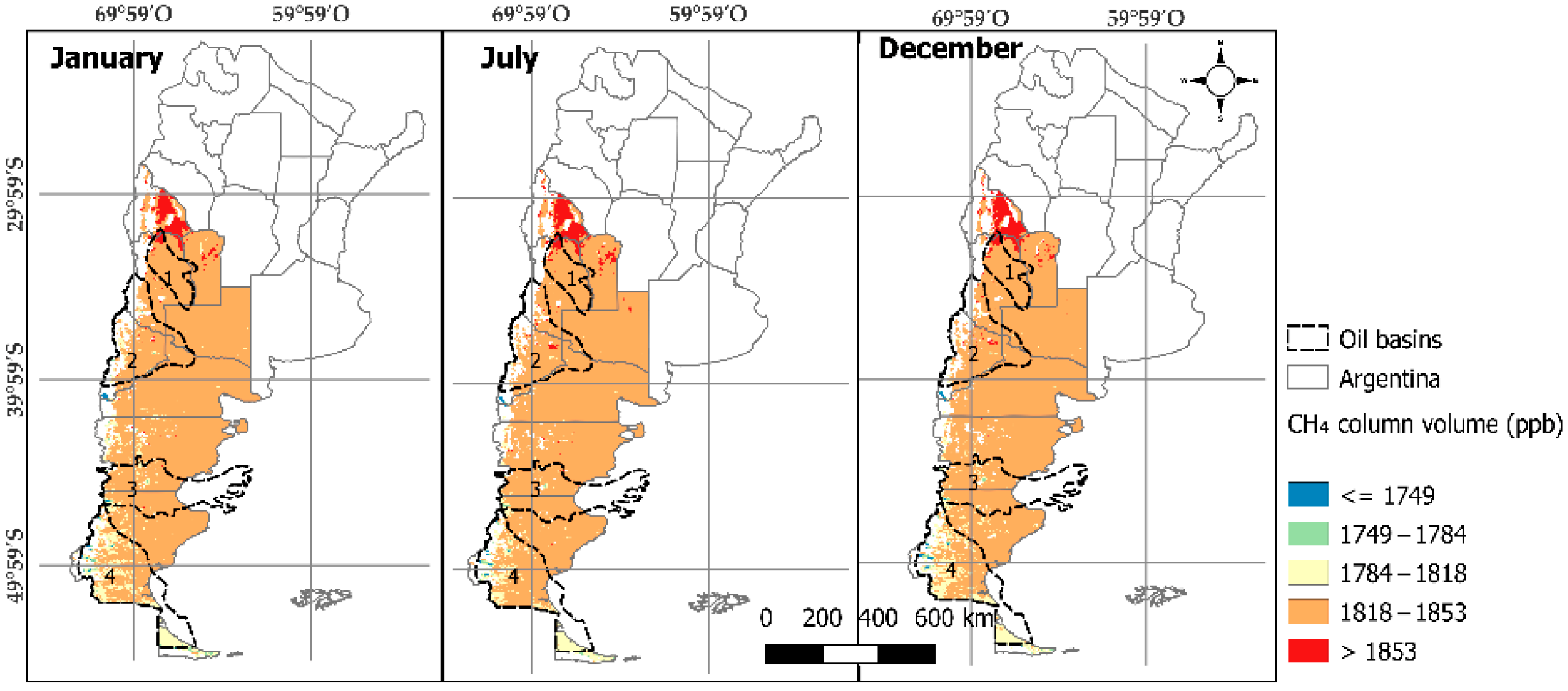
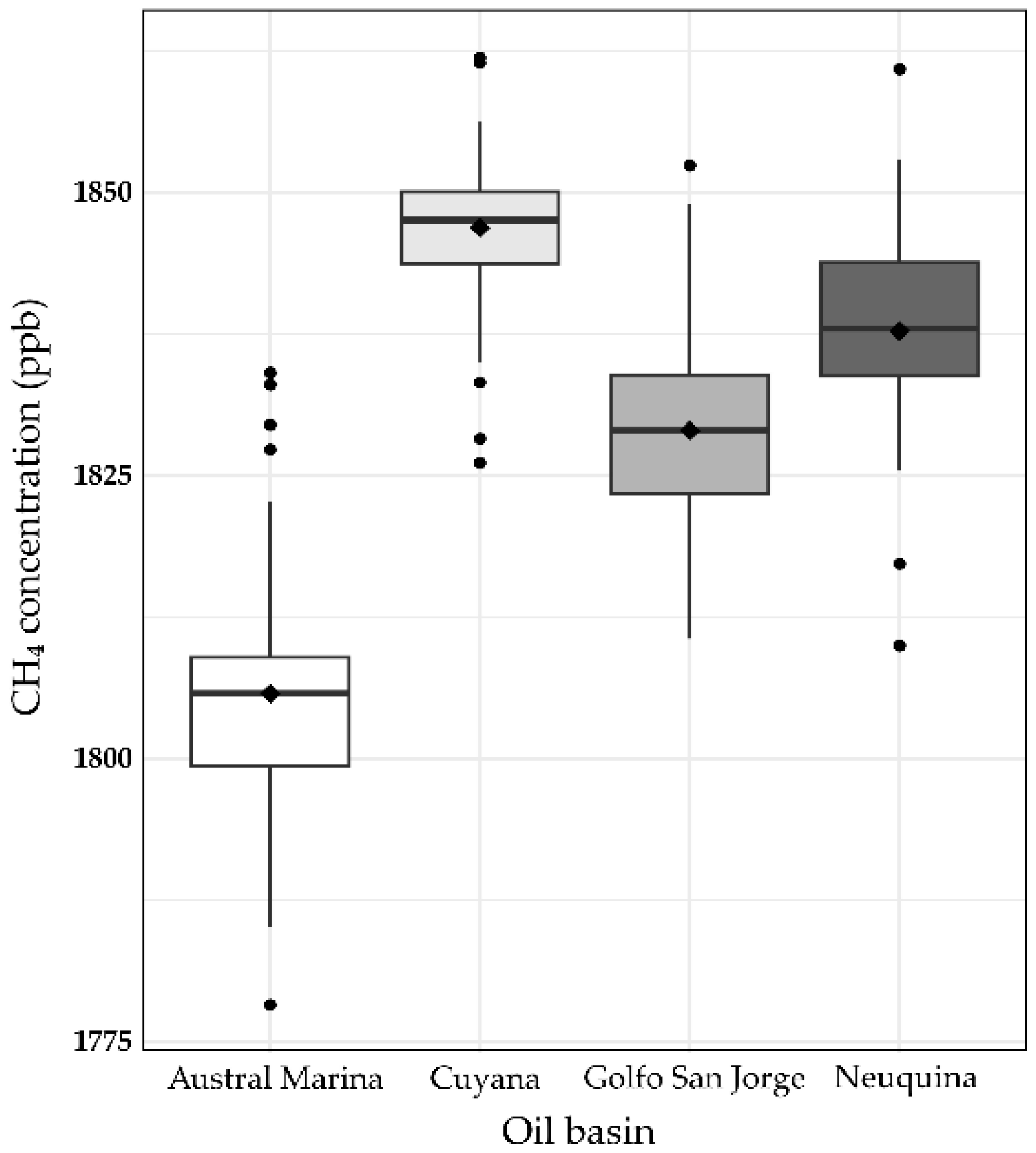
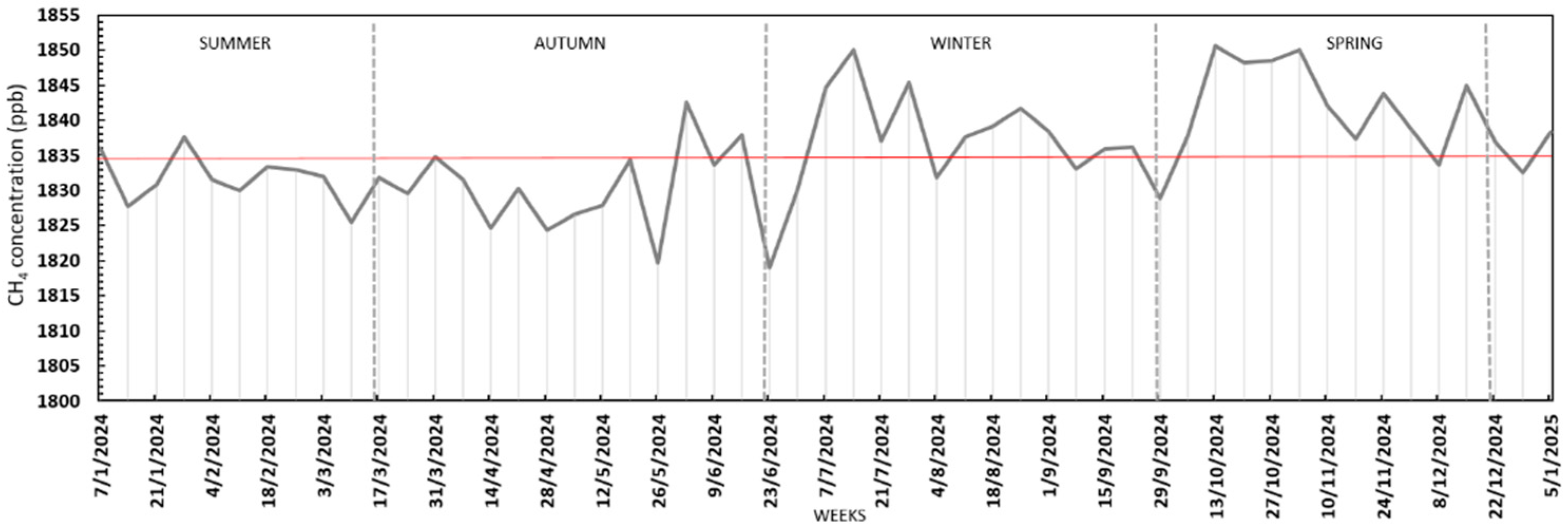

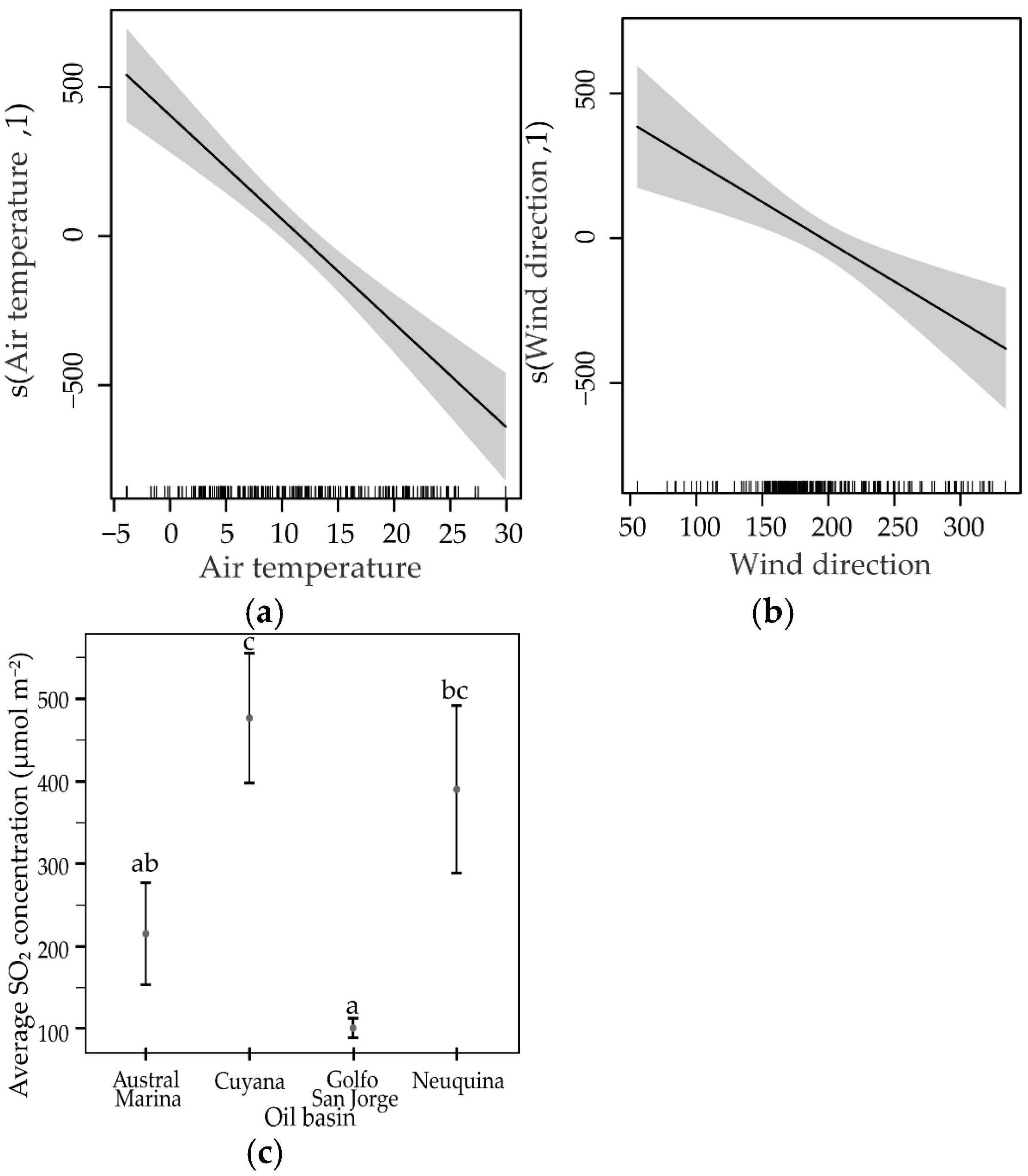
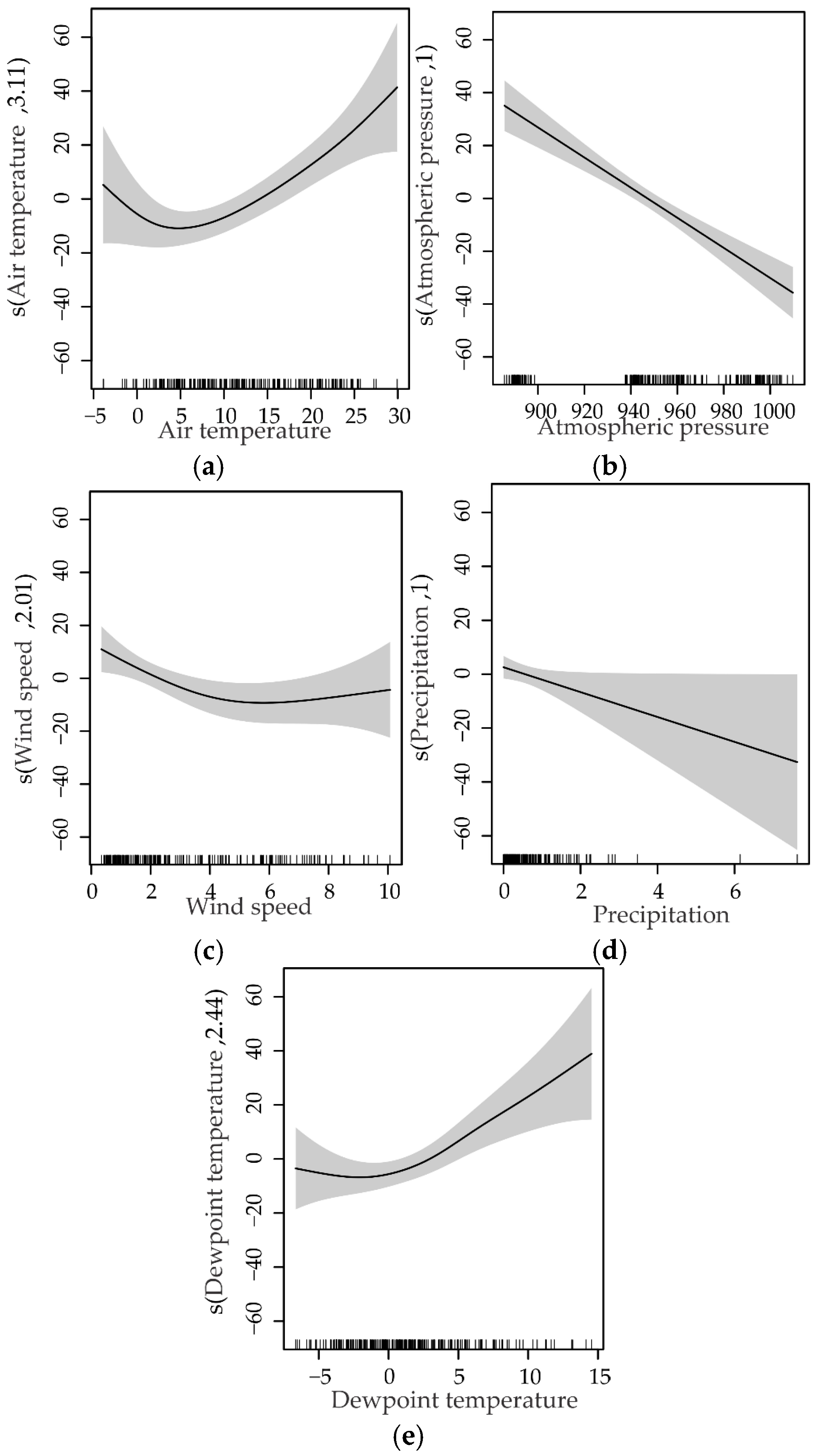
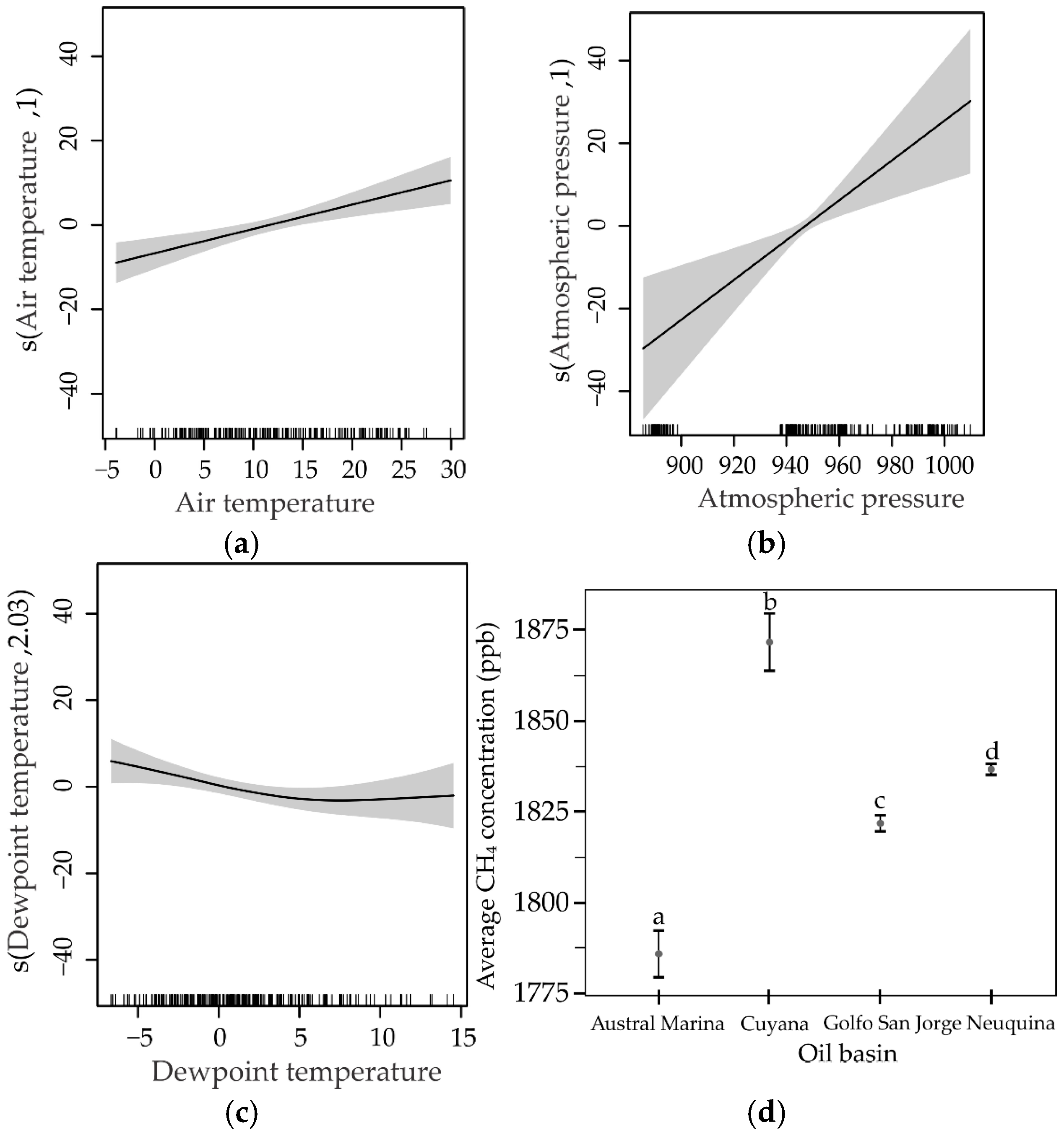
| Gas Pollutant | Maximum Observed Value During 2024 | Effect of Major Meteorological Variables | Main Risks to Health and the Environment |
|---|---|---|---|
| CO | >30,000 µmol m−2 in October (Neuquina basin) |
|
|
| SO2 | >2000 µmol m−2 in June (Cuyana and Neuquina basins) |
|
|
| HCHO | >100 µmol m−2 in January (Cuyana basin) |
|
|
| CH4 | >1850 ppb in July and October (Cuyana basin) |
|
|
Disclaimer/Publisher’s Note: The statements, opinions and data contained in all publications are solely those of the individual author(s) and contributor(s) and not of MDPI and/or the editor(s). MDPI and/or the editor(s) disclaim responsibility for any injury to people or property resulting from any ideas, methods, instructions or products referred to in the content. |
© 2025 by the authors. Licensee MDPI, Basel, Switzerland. This article is an open access article distributed under the terms and conditions of the Creative Commons Attribution (CC BY) license (https://creativecommons.org/licenses/by/4.0/).
Share and Cite
Fernández Maldonado, V.N.; Navas, A.L.; Mazza, G.; Fabani, P.; Rodriguez, R. Towards Sustainable Hydrocarbon Extraction: A Study of Atmospheric Pollutant Dynamics (CO, CH4, SO2, HCHO) via Remote Sensing and Meteorological Data. Sustainability 2025, 17, 8443. https://doi.org/10.3390/su17188443
Fernández Maldonado VN, Navas AL, Mazza G, Fabani P, Rodriguez R. Towards Sustainable Hydrocarbon Extraction: A Study of Atmospheric Pollutant Dynamics (CO, CH4, SO2, HCHO) via Remote Sensing and Meteorological Data. Sustainability. 2025; 17(18):8443. https://doi.org/10.3390/su17188443
Chicago/Turabian StyleFernández Maldonado, Viviana N., Ana Laura Navas, Germán Mazza, Paula Fabani, and Rosa Rodriguez. 2025. "Towards Sustainable Hydrocarbon Extraction: A Study of Atmospheric Pollutant Dynamics (CO, CH4, SO2, HCHO) via Remote Sensing and Meteorological Data" Sustainability 17, no. 18: 8443. https://doi.org/10.3390/su17188443
APA StyleFernández Maldonado, V. N., Navas, A. L., Mazza, G., Fabani, P., & Rodriguez, R. (2025). Towards Sustainable Hydrocarbon Extraction: A Study of Atmospheric Pollutant Dynamics (CO, CH4, SO2, HCHO) via Remote Sensing and Meteorological Data. Sustainability, 17(18), 8443. https://doi.org/10.3390/su17188443









